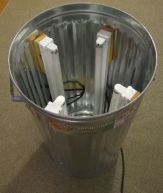
Drying Varnish
There is a saying in violin making that it takes about only a few years to learn the basics of constructing instruments, but it takes the rest of your life you learn varnishing. A UV Varnish Drying cabinet can speed up the entire finishing process.
Traditional oil varnishes are a combination of drying oil (for example, walnut or linseed), a resin (for example, copal or amber), and a thinner. While initial drying of varnish is accomplished by the evaporation of the thinner, the curing of the varnish is a chemical process; the varnish alters at an molecular level. The curing, or polymerization, of the varnish is accelerated by UV light. Alcohol based varnishes, notably used in the French tradition after the Cremona golden period, do not require this method. Based on my research, I’m certain that the Cremonese makers used oil varnish.
Tanning instruments (both in the white and after coats of varnish) is a common technique in violin making. Exposure to artificial UV light effectively replaces exposure to sunlight. This is useful in areas which have lower sunlight exposure due to winter, or where exposure to direct sunlight isn’t practical (the glass in household windows blocks a large portion of UV light). Aside from curing varnish, sunlight is also used to ‘tan’ an instrument which darkens the flaming of maple.
CAUTION: exposure to UV light causes cataracts and skin cancer, just like over exposure to the sun. The bulbs I recommend below should be fairly safe for short period of exposure, but its best to avoid prolonged exposure.
The UV cabinet is a tool which provides a way to accelerate the exposure of the instrument to UV both for tanning of the bare wood, and accelerating the curing of the varnish between coats. An instrument may be tanned for one or multiple weeks, while varnish exposed to UV will cure overnight.

The UV “Cabinet”
A simple, cost effective method of building a UV cabinet is the steel can cabinet. Not glamorous :), but certainly low cost and functional. This consists of a galvanized steel rubbish bin or garbage can, with UV florescent lights mounted vertically inside the can. A small amount of electrical expertise is required.

